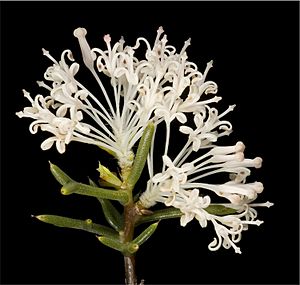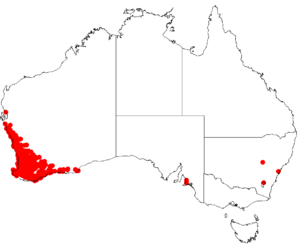Honey bush facts for kids
Quick facts for kids Honey bush |
|
|---|---|
 |
|
| Hakea lissocarpha growing near Aldersyde | |
| Scientific classification | |
| Genus: |
Hakea
|
| Species: |
lissocarpha
|
 |
|
| Occurrence data from AVH | |
The Hakea lissocarpha, often called honey bush or the duck and drake bush, is a special type of shrub. It's part of the Hakea plant family. You can find this plant growing naturally in many parts of Western Australia, including the Mid West, Wheatbelt, Peel, South West, Great Southern, and Goldfields-Esperance regions.
What it Looks Like
This honey bush is a dense, spreading shrub that usually grows between 0.4 and 1.5 meters (about 1.3 to 5 feet) tall. It has smooth or slightly rough grey bark. A cool thing about it is that it has a special woody swelling at its base called a lignotuber. This helps the plant regrow after a fire.
The honey bush blooms from May to September. Its flowers are very sweet-smelling and come in white, cream, yellow, or pink colors. They grow in clusters called racemes where the leaves meet the stem and on the upper branches.
Its leaves are short and round, like a pencil (this is called terete). They are also sharply pointed and divided into many small parts. The fruit of the honey bush is shaped like an egg (this is called ovoid). It's smooth or a bit rough and warty. Each fruit is about 1.5 to 2 centimeters (0.6 to 0.8 inches) long and tapers into two short, beak-like points.
How it Got its Name
The Hakea lissocarpha was first officially described in 1830 by a botanist named Robert Brown. The name lissocarpha comes from two Greek words: lissos, which means "smooth," and carphos, which means "dry grass." This name refers to the smooth, dry leaf-like parts (bracts) that surround the flower buds before they open.
Where it Grows and Lives
This plant is very common and can be found in many different places, from the coast near Northampton all the way to Israelite Bay. It grows well in areas with heath (low-growing shrubs) or woodlands. You can find it in sandy soil, loamy soil, or even in rocky areas with lateritic gravel or limestone.
The honey bush likes sunny or partly shaded spots and needs soil that drains water well. People sometimes use it for hedges in gardens, and it's also a great plant for wildlife because it provides habitat. It's tough too, as it can handle both dry conditions and frost.
Conservation Status
The Western Australian Government has officially classified Hakea lissocarpha as "not threatened." This means there are plenty of these plants in the wild, and they are not currently at risk of disappearing.

